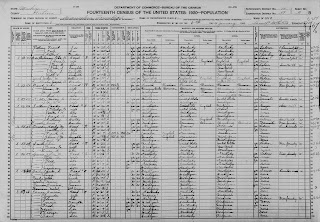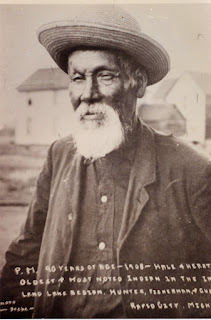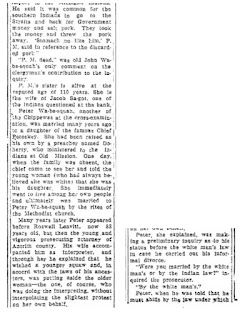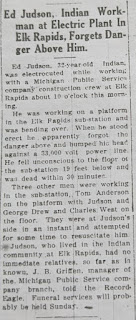family #4
Mamgona, Eliza, head, owns mortgaged farm, 70, widowed, can't read/write, born Michigan, parents born Michigan, speaks English, farmer on general farm.
James, son, 48, can read/write, born Michigan, parents born Michigan,speaks English, farmer on home farm
Ben, son, 46, can read/write, born Michigan, parents born Michigan, speaks English, farmer on home farm
Francis, son, 42, can read/write, born Michigan, parents born Michigan, speaks English, farmer on home farm
Tillie, daughter-in-law, 19, can read/write, born Michigan, parents born Michigan, speaks English
Gladys, 4/12, granddaughter, born Michigan, parents born Michigan
family #32
White, Peter, head, own free, 70, can't read/write, born Michigan, parents born Michigan, speaks English, farm laborer, working out
Mary, wife, 61, white, to US 1861, naturalized 1872, can read, can't write, born Canada, father born England, mother born Ireland, speaks English
Van, John H., grandson, 1 6/12, born Michigan, parents born Michigan
family #33
White, John, head, rents, 80, single, can't read/write, born Michigan, parents born Michigan, speaks English, farm laborer, working out
family#72
Sogod, Jacob, head, rents, 70, can't read/write, born Michigan, parents born Michigan, speaks English, farmer on general farm
Mary M., wife, 80, can't read/write, born Michigan, parents born Michigan, does not speak English
George, John, boarder, 70, widowed, can't read/write, born Michigan, parents born Michigan, does not speak English, farm laborer, working out.
family #122
Fox, Amos, head, own mortgaged, 60, widowed, can read/write, born Michigan, parents born Michigan, speaks English, farmer on general farm
William, son, 32, single, can read/write, born Michigan, parents born Michigan, speaks English, farm laborer, working out
Jesse, son, 30, single, can read/write, born Michigan, parents born Michigan, speaks English, farm laborer, working out
Ella, daughter, 28, single, can read/write, born Michigan, parents born Michigan, speaks English, waiter at restaurant
Fred, son, 26, single, can read/write, born Michigan, parents born Michigan, speaks English, farm laborer, working out
Ben, son, 24, single, can read/write, born Michigan, parents born Michigan, speaks English, farm laborer, working out
Mary, daughter, 17, not attending school, can read/write, born Michigan, parents born Michigan, speaks English, farm laborer, working out
Lottie, daughter, 15, attending school, can read/write, born Michigan, parents born Michigan, speaks English
Edward, son, 14, attending school, can read/write, born Michigan, parents born Michigan, speaks English
Rosa, daughter, 12, attending school, can read/write, born Michigan, parents born Michigan, speaks English
Albert, son, 6, attending school, can't read/write, born Michigan, parents born Michigan, speaks English
Some of the people who lived in Milton township in the past or would in the future are found in Lumber Camp 31 near Mancelona in Antrim county.
family #211
Daniels, William, head, rents, 70, can't read/write, born Michigan, parents born Michigan, speaks English, laborer in lumber woods
Jennie, wife, 50, can't read/write, born Michigan, parents born Michigan, doesn't speak English.
Shocko, Lily, grandchild, 21, can't read/write, born Michigan, parents born Michigan, speaks English
family #213
Wesley, Frank, head, rents, can't read/write, born Michigan, parents born Michigan, speaks English, laborer in lumber woods
Alice, wife, 44, can't read/write, born Michigan, parents born Michigan, doesn't speak English
Elizabeth, daughter, 3 9/12, born Michigan, parents born Michigan.
family #214
Green, Johnson, head, rents, 57, can't read/write, born Michigan, parents born Michigan, speaks English, laborer in lumber woods
Susan, wife, 35, can't read/write, born Michigan, parents born Michigan, speaks English
Eva, daughter, 7, attends school, born Michigan, parents born Michigan
John, son, 4, born Michigan, parents born Michigan
William, son, 6/12, born Michigan, parents born Michigan
family #215
Russett, George W., head, rents, 35, can read/write, born Michigan, parents born Michigan, speaks English, laborer in lumber woods
Julia, wife, 25, can read/write, born Michigan, parents born Michigan, speaks English
Paul, son, 5, born Michigan, parents born Michigan
Lucy, daughter, 3 9/12, born Michigan, parents born Michigan
Joseph, son, 1 6/12, born Michigan, parents born Michigan
family #221
Wilson, William P., boarder (with Otho A. Payne and his family), 20, can read/write, born Michigan, parents born Michigan, speaks English, laborer in lumber woods
family #223
Smith, William K., head, rents, 47, can read/write, born Michigan, parents born Michigan, speaks English, laborer in lumber woods
Mary, wife, 43, can't read/write, born Michigan, parents born Michigan, doesn't speak English
Robert P., son, 21, can read/write, born Michigan, parents born Michigan, speaks English, laborer in lumber woods
Anna, daughter, 13, attends school, can read/write, born Michigan, parents born Michigan, speaks English
Alden, son, 11, attends school, can read/write, born Michigan, parents born Michigan, speaks English
Cora, daughter, 8, attends school, can read/write, born Michigan, parents born Michigan, speaks English
Wallace, son, 1/12, born Michigan, parents born Michigan
Another family with later Kewadin connections is that of Charles S. Baily, found in Mancelona township.
family #60
Baily, Charles S., head, 52, can't read/write, born Michigan, parents born Michigan, speaks English, sawer in lumber woods
Baily, Lucy, mother, 73, can't read/write, born Michigan, parents born Michigan, speaks English
On 14 Jun 1926, Peter Mark Nah-we-ke-zhick, who lived in Kewadin many years before moving to Aarwood, near Rapid City in Kalkaska county, died in Leelanau County. His father, Pashawnaquong, was one of the ten first land owners in Milton township. Old P.M. as he was called, was buried in the Kewadin Indian Mission cemetery.
Traverse City Record Eagle 27 Jun 1927 page 10. Part was reprinted 27 Jun 1928 page 26
SPIRIT OF OLD TORCH ON GUARD
BURIED INDIAN GOLD FOR WHICH WHOLE TRIBE DIED DEFIES ALL SEARCH
Descendants Of Warriors Rebuke White Men With Silence—Torch Lake Region Rich In Legend
The colorful Torch Lake region is the setting for many Indian legends left by the tribes whose descendants now have all but vanished. Most of the Indian tales are legends. Some are not. Some are trace back to a gleam of tact. One such is the weird tale of buried gold on an Antrim count farm whose soil has already yielded many Indian relics and skeletons, and its probability is strongly suggested by the reluctance of the last surviving Indians to talk about it.
For more than 20 years John Steiner, living back from the east shore of Torch lake, has been cognizant of the legend that on his farm was fought a battle between three Indian tribes for a huge sum in gold paid them for their lands by United States government. He has heard from the descendants of these Indians of the quarrel over the distribution of the cash—of how the tribe which held the money buried it on his place and then died to the last man rather than divulge the secret.
Certainly no piece of land in Antrim county has been turned over quite as much as John Steiner’s even before the story had got abroad that when the timer was first cut on it, Indians in the vicinity showed an odd interest in the proceedings. When John Steiner’s father, who bought the place 33 years ago, started to pull the stumps the nearby Indians squatted about him and watched the operations with the closet attention.
After the son came into the ownership of the place two decades ago a very old Indian, one Jacob Solomon, said: “No sell this land—ever. No sell him! Dig! Plow! Bimeby, when sweat run down face from hot summer sun, plow go bump. You find something. Then no more you sweat to plant the corn and potatoes. Other white men sweat for you. You have gold to pay ‘em for sweating!”
Solomon, sober, would say no more. But Solomon, in his cups, hinted enough at what the plow might bump into to cause Bud White and Maurice Corey—the latter a printer and antiquarian living in Bellaire—to seek and get Mr. Steiner’s permission to dig on his land. A skeleton was unearthed in a ridge. Scores of arrow-heads, broken tomahawks, metal ornaments and such have been found in the ground. But so far no treasure has been uncovered.
Although the story is out and is stirring the curiosity of the countryside. John Steiner and his friends are reluctant to talk. The Indians at nearby Kewadin, who are descendants of the two tribes that exterminated the tribe supposed to have buried the gold before making the division to which the others felt themselves entitled, are not any more communicative.
But two of the principal bankers of the county—William H. Richards of the Bellaire State Bank, and Charles B. Carver, president of the Elk Rapids State Bank, have heard the story. In fact, it was in the Elk Rapids State Bank recently that old John Wa-be-quah, Peter Wa-be-squah, his younger brother: Jacob Sa-got and several other Chippewas, were questioned through Peter Anse, a French-Indian interpreted.
“He say,” said the interpreter pointing to Peter Wa-be-squah, “that tribe tradition tell of brass kettles of gold buried long ago somewhere around here.”
“Ask him where?” commanded Mr. Carver
Chippewa talk intervened, with Peter shaking his head vigorously.
“He say he don’t know where,” was the English result of a heated coloquy.
While this was going on the older brother, John Wa-be-squah, reported to have been present with Jacob Solomon and later to have made similar remarks to John Steiner about holding the land in question for the sake of the gold, grunted loudly and shook his head at his younger brother in what seemed deep disgust at the white man’s attempts to wrest a secret from an Indian.
The Rev. J. C. Mathews, Elk Rapids Methodist paster and also in charge of the Indian mission at the nearby village of Kewadin, was unable to induce the elder Indian to do more than grunt general denials that he knew anything about the hidden treasure.
“P. M. once told me,” said the clergyman referring to Peter Mark, a widely known Chippewa who died in 1925 at the age c.106 years, “that he remembered an Indian came who came from the Sacs, in Wisconsin, by way of the Straits at Mackinac, with news of great import to the Michigan Indians. He said it was common for the southern Indians to go the Straits and back for Government money and salt pork. They took the money and threw the pork away. ‘Stomach no like him’ P.M. said in reference to the discarded pork.”
“P. M. dead,” was old John Wa-be-squah’s only comment on the clergyman’s contribution to the inquiry.
P. M.’s sister is alive at the reputed age of 110 years. She is the wife of Jacob Sa-got, one of the Indians question at the bank.
Peter Wa-be-squah, another of the Chippewas at the cross-examination, was married many years ago to a daughter of the famous Chief Petoskey. She had been raised as his own by a preached (sic) named Doherty, who ministered to the Indians at Old Mission. One day, when the family was absent, the chief came to see her and told the young woman (who had always believed she was white) that she was his daughter. She immediately went to live among her own people and ultimately was married to Peter Wa-be-squah by the rited of the Methodist church.
Many years later Peter appeared before Roswell Leavitt, now 84 years old, but then the young and vigorous prosecuting attorney of Antrim county. His wife accompanied his as interpreter, and through her he explained that he wished a younger squaw and, in accord with the laws of his ancestors, was putting aside the older woman—the one, of course, who was doing the interpreting, without interpolating the slightest protest on her own behalf.
Peter, she explained, was making a preliminary inquiry as to his status before the with man’s law in case he carried out his informal divorce.
“Were you married by the white man’s or by the Indian law?” inquired the prosecutor.
“By the white man’s”
Peter, when he was told that he must abide by the under which the marriage was contracted, lived with the chief’s daughter until she died.
When the inquiry into the treasure trove supposed to be lying below the John Steiner acres adjourned from the bank to Peter’s cabin in Kewadin the investigators found there a second wife—white, well mannered and winsome. It is said that once she was married to a white man. She was being beaten by her husband when Petr, (sic) their neighbor, intervened, and won the lady’s admiration by punishing her mate with his fists. After the resulting divorce Peter, by that time a widower, married her, He is today a canoe maker and both he and his wife are highly respected in the county.
P. M.’s sister, who also was visited, looked and acted as old as her reputed 110 years and consequently was useless as a witness.
The Indian gold on John Steiner’s farm is not the only treasure trove which Antrim County holds. Somewhere in the east arm of Traverse Bay lies a schooner Icaded with a cargo of old-fashioned rum that antedates the advent of prohibition by more than half a century.
She was scutted by her smuggler captain when government boats were uncomfortably close in his wake. The spot was marked by a buoy. But a storm rose and unloosened the buoy’s mooring so that all trace of the schooner was lost. Tradition says that she lies in 750 feet of water some three miles north of Elk Rapids.
[1928 version ends here.]
Indian relics by the score have been found on the Steiner farm. That it was used for a considerable time as a camping ground is indicated by the numerous fire holes, plainly apparent even with snow on the ground. Excavation of almost any of these fire holes brings to the surface broken kettles, pottery and other utensils of aboriginal origin. The knoll near the Steiner farmhouse revealed the skeleton. In addition, arrowheads and metal ornaments of all kinds are abundant there. Successive plowing downhill for many years has reduced the knoll to a height of about 20 feet.
“My father,” admits John Steiner, “was told the story the first year he occupied that land. That was 33 years ago. It was common talk among the homesteaders in the vicinity.”
The fact that Steiner, who is a carpenter and has no practical use for the farm, has refused several proposed purchases, causes many to feel that he believes the treasure legend and will not part with the land until he has unearthed it.
Traverse City Record Eagle 27 Jun 1927 page 10
copyright (c) 2023 Vicki Wilson





































No comments:
Post a Comment